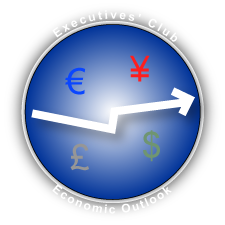U.S. Economy Due for Sideways Year—Special Effects by Presidential Election—Uncomfortable Long-term Questions Waiting in Wings
 The Executives’ Club of Chicago assembled an all-star panel to give Midwest business leaders their guidance for various aspects of the U.S. economy in 2008. Diane Swonk, Chief Economist of Mesirow Financial and Robert “Bob” Froehlich, Chairman of the Investment Strategy Committee, Deutsche Asset Management returned, and the mystery panelist was Jack Ablin, Chief Investment Officer, Harris Private Bank. They broke out their respective crystal balls for 2008, along with comedic effects. The session was brilliantly moderated by Terry Savage, Financial Columnist of the Chicago Sun-Times who didn’t miss a beat and extracted specific predictions from panelists. The Executives’ Club of Chicago assembled an all-star panel to give Midwest business leaders their guidance for various aspects of the U.S. economy in 2008. Diane Swonk, Chief Economist of Mesirow Financial and Robert “Bob” Froehlich, Chairman of the Investment Strategy Committee, Deutsche Asset Management returned, and the mystery panelist was Jack Ablin, Chief Investment Officer, Harris Private Bank. They broke out their respective crystal balls for 2008, along with comedic effects. The session was brilliantly moderated by Terry Savage, Financial Columnist of the Chicago Sun-Times who didn’t miss a beat and extracted specific predictions from panelists.
Panelists agreed that the U.S. economy would struggle in 2008, but it would move mostly sideways, probably eking out a 1-2% gain for the year after an unsatisfying first half. All panelists predicted that the Dow would touch 14,000 sometime during the year. Froehlich again emphasized the importance of looking beyond the U.S. for investments. Swonk and Ablin were less outspoken but had high non-U.S. allocations in their recommended […]
Year in Review 2007—Editor’s Choice of the Global Human Capital Journal
 As I reflect on 2007 and create strategy for 2008, several macro-trends come into sharp relief, and I believe that some of them might be helpful to you as you conduct your own planning. As always, I focus on emerging phenomena because they are areas in which disruption and discontinuous change are acting on markets, thereby elevating threats and opportunities. Helping leaders to create strategy to manage the risk of unusual market developments is the focus of my consulting practice. As I reflect on 2007 and create strategy for 2008, several macro-trends come into sharp relief, and I believe that some of them might be helpful to you as you conduct your own planning. As always, I focus on emerging phenomena because they are areas in which disruption and discontinuous change are acting on markets, thereby elevating threats and opportunities. Helping leaders to create strategy to manage the risk of unusual market developments is the focus of my consulting practice.
In 2007 it became clear to me that we were entering a profound social transformation that would produce an unimaginable degree of change. Unlike the technology-precipitated change that I’ve been helping people with since the 1990s, technology is shifting to the background now, and pervasive social change is taking the stage. Look for disruption in all areas affected by how people connect, communicate, purchase and collaborate: business, politics, community and leisure. Moreover, these changes are completely global with all the variations that engenders.
I can’t tell […]
How Social Tagging Changes the Economics of Ecommerce was a geeky session that explained how a potent mix of “people like me” navigation and digital leverage can drive sales and profits + The secret to emerging markets?
 The Global Human Capital Journal’s coverage of the Forrester Consumer Forum 2007 continues with this session on social tagging. Before your eyes glaze over, bear with me and learn how this simple, revolutionary social technology can help your customers to help your business. Forrester’s Sarah Rotman Epps moderated a discussion with Brian Rosenblat, Online Retail Industry Lead, Endeca Technologies and Jay Shaffer, Vice President Marketing, PowerReviews, who represented companies that offer social tagging solutions, and they all shared numerous examples. The Global Human Capital Journal’s coverage of the Forrester Consumer Forum 2007 continues with this session on social tagging. Before your eyes glaze over, bear with me and learn how this simple, revolutionary social technology can help your customers to help your business. Forrester’s Sarah Rotman Epps moderated a discussion with Brian Rosenblat, Online Retail Industry Lead, Endeca Technologies and Jay Shaffer, Vice President Marketing, PowerReviews, who represented companies that offer social tagging solutions, and they all shared numerous examples.
This was one of the most “actionable opportunity” sessions of the conference: tagging is a relatively unknown, simple, yet transformational Web 2.0 phenomenon that will gain traction in 2008 and explode in 2009. If you aren’t doing it, you will be at a significant disadvantage to your competitors who do.
The Global Human Capital Journal published the overall conference […]
A Paradoxical Proposition, Are People More Real Where They Live Their Dreams?—Zapped by Conventional Thinking
 Gaming and virtual worlds like Second Life have been a hot topic due to their novelty and, where gaming is concerned, their Gen X and Gen Y demographics. However, early adopter marketers who have flocked to virtual worlds to create presences there have often been disappointed. Forrester’s Paul Jackson is a long-time follower of gaming and virtual worlds, and he gave a fascinating and valuable session on the status and best practices for how marketers can approach this new medium. He also gave a rough ROI picture of investing. Just like anything, if you approach virtual worlds with appropriate goals, you can benefit significantly. Gaming and virtual worlds like Second Life have been a hot topic due to their novelty and, where gaming is concerned, their Gen X and Gen Y demographics. However, early adopter marketers who have flocked to virtual worlds to create presences there have often been disappointed. Forrester’s Paul Jackson is a long-time follower of gaming and virtual worlds, and he gave a fascinating and valuable session on the status and best practices for how marketers can approach this new medium. He also gave a rough ROI picture of investing. Just like anything, if you approach virtual worlds with appropriate goals, you can benefit significantly.
An Overview of Games and Virtual Worlds
Jackson began with a history of virtual worlds and gaming, which are both inherently social (and usually sticky). Gaming began in the 1970s with multiuser Dungeons, and many early games were played on the VAX. The 1990s introduced 3-D graphics and VRML as well as massively multiuser games like Lineage, EverQuest and the World […]
… Risky, Loaded and Ready to Help You Improve Your Business
 The Global Human Capital Journal’s coverage of the Forrester Consumer Forum 2007 continues with this session on the disruptive power of customers’ Web 2.0 activity. Charlene Li, Vice President and Principal Analyst, Forrester Research, briefed the conference on the disruptive character of consumer empowerment, which she and Josh Bernoff call “groundswell.” She explained why customers were revolting, a “ladder of participation” to describe who is driving the change and some suggestions for turning revolt into reform. The Global Human Capital Journal’s coverage of the Forrester Consumer Forum 2007 continues with this session on the disruptive power of customers’ Web 2.0 activity. Charlene Li, Vice President and Principal Analyst, Forrester Research, briefed the conference on the disruptive character of consumer empowerment, which she and Josh Bernoff call “groundswell.” She explained why customers were revolting, a “ladder of participation” to describe who is driving the change and some suggestions for turning revolt into reform.
The Global Human Capital Journal published the overall conference wrap as well as in-depth coverage of several sessions. Access all through the link to the conference logo (right). Other articles will be published in the days ahead, and we invite you to subscribe to the forum’s RSS feed to be notified as they are published.
I assume that the title’s double entendre was intentional, but in any case, it captures many marketers’ attitudes toward the so-called Web 2.0 revolution. “We don’t want our customers to change. We want to maintain our marketing […]
Social Computing at an Inflection Point—Preparing to Be Overwhelmed
 The Global Human Capital Journal’s coverage of the Forrester Consumer Forum 2007 continues with this session on Delta’s experience with customer blogs. Moderator Henry H. Harteveldt did an excellent job setting up the session and letting Laura R. Hunnicutt, Delta’s General Manager of Customer Experience, talk with the audience about some real-world practical problems of moving executives’ legacy thinking to Web 2.0. Having enterprise visionaries and thought leaders added tremendous value to the conference. The Global Human Capital Journal’s coverage of the Forrester Consumer Forum 2007 continues with this session on Delta’s experience with customer blogs. Moderator Henry H. Harteveldt did an excellent job setting up the session and letting Laura R. Hunnicutt, Delta’s General Manager of Customer Experience, talk with the audience about some real-world practical problems of moving executives’ legacy thinking to Web 2.0. Having enterprise visionaries and thought leaders added tremendous value to the conference.
The Global Human Capital Journal published the overall conference wrap and will have several other in-depth articles in the days ahead. You can be notified as to their publication by subscribing to the forum’s RSS feed.
This session showed that social computing can have a powerful strategic impact at inflection points in companies’ histories. As everyone knows, Delta is recently out of bankruptcy, and the airline business is difficult on a good day. The company is in a period of high risk-high reward, and Laura gave the audience a heartfelt behind-the-scenes look at the company’s Web […]
Dell and Procter & Gamble Innovation Leaders Share Web 2.0 Transformation Insight—The Slow Boil
 The Global Human Capital Journal’s coverage of the Forrester Consumer Forum 2007 continues with this session on what I’ll hazard to call Innovation 2.0 ,^). David Armano of Critical Mass moderated this an infectious session. It was clear that Proctor & Gamble’s Stan Joosten and Dell’s Manish Mehta had been in the innovation trenches, and their comments were extremely valuable. The Global Human Capital Journal’s coverage of the Forrester Consumer Forum 2007 continues with this session on what I’ll hazard to call Innovation 2.0 ,^). David Armano of Critical Mass moderated this an infectious session. It was clear that Proctor & Gamble’s Stan Joosten and Dell’s Manish Mehta had been in the innovation trenches, and their comments were extremely valuable.
A key ingredient to Web 2.0’s transformational potential is that the technology is an order of magnitude more explicit, easy to use and less costly. It’s possible, and desirable in many cases, to take small steps. On the other hand, Dell took a risky step in launching Direct to Dell in the midst of serious customer service problems, and it leveraged blogs to turn the situation around.
The Global Human Capital Journal published the overall conference wrap as well as in-depth coverage of several sessions. Access all through the link to the conference logo (right). Other articles will be published in the days ahead, and […]
Case Studies Presage Imminent Adoption of Social Technologies—Emerging Markets Prize In Balance
 A who’s who of global marketing executives convened on the Hilton Chicago October 11-12, 2007 for two days of cramming on social networks, emerging technology and transformation. It certainly felt like an inflection point: analysts’ insights and technology pioneers’ zeal were tempered by corporate stories in the trenches. Based on my experience with previous adoption curves, I predict a significant jump in Web 2.0 adoption by corporations next year. A who’s who of global marketing executives convened on the Hilton Chicago October 11-12, 2007 for two days of cramming on social networks, emerging technology and transformation. It certainly felt like an inflection point: analysts’ insights and technology pioneers’ zeal were tempered by corporate stories in the trenches. Based on my experience with previous adoption curves, I predict a significant jump in Web 2.0 adoption by corporations next year.
Depending on your industry, the next six months will be your last chance to be early to market. As success stories become more widespread and executives realize that Web 2.0 has very low barriers to adoption due to the social Zeitgeist and a relatively low price point, the use of social technologies will rapidly become mainstream. The main barrier to adoption is cultural resistance and organizational inertia.
Although this was not a technology conference, in my conclusions, I will provide some insights about why and how Web 2.0 represents a fundamentally new technology value proposition that makes it […]
Content Providers Hobbled by Conventional Thinking—UGC May Fill Content Vacuum in Plum Mobile Video Market
 At Digital Hollywood Chicago, speakers held that video would grow significantly as a portion of content experienced on the three screens. However, no panelist gave a compelling reason that video would grow—and there are many problems that will dampen adoption in the short- to medium-term. I question whether they are just trying to drive demand to drive their businesses. Don’t forget that this conference is digital Hollywood. At Digital Hollywood Chicago, speakers held that video would grow significantly as a portion of content experienced on the three screens. However, no panelist gave a compelling reason that video would grow—and there are many problems that will dampen adoption in the short- to medium-term. I question whether they are just trying to drive demand to drive their businesses. Don’t forget that this conference is digital Hollywood.
Myopia is content owners’ biggest problem: they seek to repurpose existing content for the mobile screen to amortize past investments. This logic permeates their thinking and prevents innovation. Meanwhile, consumers are awakening to the excitement of consumer-produced content, the prices of software tools are falling, and skills are increasing. True, the production quality is usually amateurish, but UGC (user-generated content) is usually free, fresh and relevant—to niches, which is where the action is. Users produce content for fun, and they can afford to address topics that “professional” content cannot. Mass-produced vapid content will still have a place in the consumer entertainment universe, but it will decreasingly […]
Pervasive Consumer Connectivity Vision Upstaged by Enterprise Web 2.0 Collaboration
 Cisco’s John Chambers is a master technology marketer who quickens your pulse with technology fire and brimstone. However, as the long-time CEO of Cisco, which epitomized the rise of the (Silicon) Valley when it was briefly the most valuable company in the U.S. in 2000, he has seen the company through the tech bust and proven that he has substance and staying power. Although a hypemeister extraordinaire, he may have crystallized the promise of the Enterprise Web 2.0 better than any other speaker at Digital Hollywood Chicago. Cisco’s John Chambers is a master technology marketer who quickens your pulse with technology fire and brimstone. However, as the long-time CEO of Cisco, which epitomized the rise of the (Silicon) Valley when it was briefly the most valuable company in the U.S. in 2000, he has seen the company through the tech bust and proven that he has substance and staying power. Although a hypemeister extraordinaire, he may have crystallized the promise of the Enterprise Web 2.0 better than any other speaker at Digital Hollywood Chicago.
Chambers’ demos of whiz-bang consumer entertainment scenarios were intriguing but far less interesting to an enterprise-focused audience than his accounts of how Cisco had drastically increased its already-leading efficiency in mergers and acquisitions by collaborating with Web 2.0 tools like wikis. We anticipate that his consumer-focused vision will be consummated far in the future, but his message about enterprise collaboration is achievable this year—for those who are looking for it.
Chambers described an emerging future of networks and communication that revolved around pervasive video, […]
|
|
 The Executives’ Club of Chicago assembled an all-star panel to give Midwest business leaders their guidance for various aspects of the U.S. economy in 2008. Diane Swonk, Chief Economist of Mesirow Financial and Robert “Bob” Froehlich, Chairman of the Investment Strategy Committee, Deutsche Asset Management returned, and the mystery panelist was Jack Ablin, Chief Investment Officer, Harris Private Bank. They broke out their respective crystal balls for 2008, along with comedic effects. The session was brilliantly moderated by Terry Savage, Financial Columnist of the Chicago Sun-Times who didn’t miss a beat and extracted specific predictions from panelists.
The Executives’ Club of Chicago assembled an all-star panel to give Midwest business leaders their guidance for various aspects of the U.S. economy in 2008. Diane Swonk, Chief Economist of Mesirow Financial and Robert “Bob” Froehlich, Chairman of the Investment Strategy Committee, Deutsche Asset Management returned, and the mystery panelist was Jack Ablin, Chief Investment Officer, Harris Private Bank. They broke out their respective crystal balls for 2008, along with comedic effects. The session was brilliantly moderated by Terry Savage, Financial Columnist of the Chicago Sun-Times who didn’t miss a beat and extracted specific predictions from panelists.
 As I reflect on 2007 and create strategy for 2008, several macro-trends come into sharp relief, and I believe that some of them might be helpful to you as you conduct your own planning. As always, I focus on emerging phenomena because they are areas in which disruption and discontinuous change are acting on markets, thereby elevating threats and opportunities. Helping leaders to create strategy to manage the risk of unusual market developments is the focus of my consulting practice.
As I reflect on 2007 and create strategy for 2008, several macro-trends come into sharp relief, and I believe that some of them might be helpful to you as you conduct your own planning. As always, I focus on emerging phenomena because they are areas in which disruption and discontinuous change are acting on markets, thereby elevating threats and opportunities. Helping leaders to create strategy to manage the risk of unusual market developments is the focus of my consulting practice. The Global Human Capital Journal’s coverage of the Forrester Consumer Forum 2007 continues with this session on social tagging. Before your eyes glaze over, bear with me and learn how this simple, revolutionary social technology can help your customers to help your business. Forrester’s Sarah Rotman Epps moderated a discussion with Brian Rosenblat, Online Retail Industry Lead, Endeca Technologies and Jay Shaffer, Vice President Marketing, PowerReviews, who represented companies that offer social tagging solutions, and they all shared numerous examples.
The Global Human Capital Journal’s coverage of the Forrester Consumer Forum 2007 continues with this session on social tagging. Before your eyes glaze over, bear with me and learn how this simple, revolutionary social technology can help your customers to help your business. Forrester’s Sarah Rotman Epps moderated a discussion with Brian Rosenblat, Online Retail Industry Lead, Endeca Technologies and Jay Shaffer, Vice President Marketing, PowerReviews, who represented companies that offer social tagging solutions, and they all shared numerous examples. Gaming and virtual worlds like Second Life have been a hot topic due to their novelty and, where gaming is concerned, their Gen X and Gen Y demographics. However, early adopter marketers who have flocked to virtual worlds to create presences there have often been disappointed. Forrester’s Paul Jackson is a long-time follower of gaming and virtual worlds, and he gave a fascinating and valuable session on the status and best practices for how marketers can approach this new medium. He also gave a rough ROI picture of investing. Just like anything, if you approach virtual worlds with appropriate goals, you can benefit significantly.
Gaming and virtual worlds like Second Life have been a hot topic due to their novelty and, where gaming is concerned, their Gen X and Gen Y demographics. However, early adopter marketers who have flocked to virtual worlds to create presences there have often been disappointed. Forrester’s Paul Jackson is a long-time follower of gaming and virtual worlds, and he gave a fascinating and valuable session on the status and best practices for how marketers can approach this new medium. He also gave a rough ROI picture of investing. Just like anything, if you approach virtual worlds with appropriate goals, you can benefit significantly. The Global Human Capital Journal’s coverage of the Forrester Consumer Forum 2007 continues with this session on the disruptive power of customers’ Web 2.0 activity. Charlene Li, Vice President and Principal Analyst, Forrester Research, briefed the conference on the disruptive character of consumer empowerment, which she and Josh Bernoff call “groundswell.” She explained why customers were revolting, a “ladder of participation” to describe who is driving the change and some suggestions for turning revolt into reform.
The Global Human Capital Journal’s coverage of the Forrester Consumer Forum 2007 continues with this session on the disruptive power of customers’ Web 2.0 activity. Charlene Li, Vice President and Principal Analyst, Forrester Research, briefed the conference on the disruptive character of consumer empowerment, which she and Josh Bernoff call “groundswell.” She explained why customers were revolting, a “ladder of participation” to describe who is driving the change and some suggestions for turning revolt into reform. At Digital Hollywood Chicago, speakers held that video would grow significantly as a portion of content experienced on the three screens. However, no panelist gave a compelling reason that video would grow—and there are many problems that will dampen adoption in the short- to medium-term. I question whether they are just trying to drive demand to drive their businesses. Don’t forget that this conference is digital Hollywood.
At Digital Hollywood Chicago, speakers held that video would grow significantly as a portion of content experienced on the three screens. However, no panelist gave a compelling reason that video would grow—and there are many problems that will dampen adoption in the short- to medium-term. I question whether they are just trying to drive demand to drive their businesses. Don’t forget that this conference is digital Hollywood. Cisco’s John Chambers is a master technology marketer who quickens your pulse with technology fire and brimstone. However, as the long-time CEO of Cisco, which epitomized the rise of the (Silicon) Valley when it was briefly the most valuable company in the U.S. in 2000, he has seen the company through the tech bust and proven that he has substance and staying power. Although a hypemeister extraordinaire, he may have crystallized the promise of the Enterprise Web 2.0 better than any other speaker at Digital Hollywood Chicago.
Cisco’s John Chambers is a master technology marketer who quickens your pulse with technology fire and brimstone. However, as the long-time CEO of Cisco, which epitomized the rise of the (Silicon) Valley when it was briefly the most valuable company in the U.S. in 2000, he has seen the company through the tech bust and proven that he has substance and staying power. Although a hypemeister extraordinaire, he may have crystallized the promise of the Enterprise Web 2.0 better than any other speaker at Digital Hollywood Chicago.